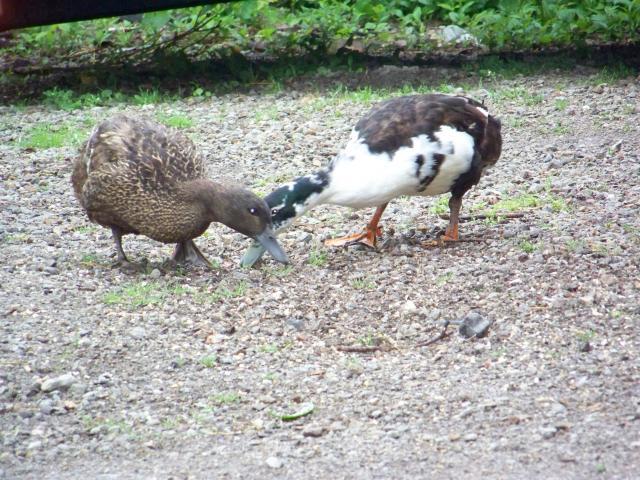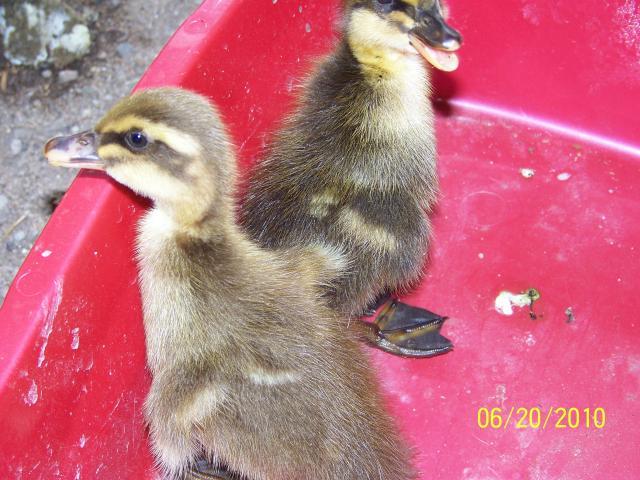the males have the buff gene right? I have a new duckling from one of my different drakes than the others and it looks like the others but it is alot lighter cream and light coco unlike the others that are black and sandy brown
Navigation
Install the app
How to install the app on iOS
Follow along with the video below to see how to install our site as a web app on your home screen.
Note: This feature may not be available in some browsers.
More options
You are using an out of date browser. It may not display this or other websites correctly.
You should upgrade or use an alternative browser.
You should upgrade or use an alternative browser.
sex-linked grey ducks
- Thread starter roocrazy
- Start date
More options
Who Replied?- Thread starter
- #2
bump
Ok, not quite sure what your meaning by "sex-linked grey ducks" do you mean Mallards? Restricted Mallards? Grey Call ducks? Grey Runners? etc.
- Thread starter
- #4
rouens.
Unless you have some mixes in earlier generations the Rouen ducklings should all be similar in color. and unless i'm missing something they don't carry the buff gene, they are wild type.
Lets look @ a couple of examples of pure & impure colour genotypes
starting with the pure wild-type bird ie the wild Mallard or Rouen. All
mutations are in red for ease of identification.
A wild-type coloured/patterned drakes genotype should as we know it
be:-
M+/M+, Li+/Li+, e+/e+, bl+/bl+, D+/D+, Bu+/Bu+, C+/C+, s+/s+,
B+/B+, W+/W+, r+/r+, y+/y+.
M+ = Wild-type Mallard
MR = Restricted Mallard
md = Dusky mallard
Li+ = Dark Phase
li = Light Phase
lih = Harlequin Phase
e+ = not black
E = Extended Black
bl+ = not blue
Bl = Blue Dilution
D+ = not brown
d = Brown Dilution (sex-linked)
Bu+ = not buff
bu = Buff Dilution (sex-linked)
C+ = not white
c = recessive white
s+ = not bibbed
S = dominant bib
B+ = not bibbed
b = recessive bib
W+ = not white primaries
w = white primaries
r+ = not pied
R = pied pattern
y+ = normal yellow skin & bill colour
Y = white skin & bill
starting with the pure wild-type bird ie the wild Mallard or Rouen. All
mutations are in red for ease of identification.
A wild-type coloured/patterned drakes genotype should as we know it
be:-
M+/M+, Li+/Li+, e+/e+, bl+/bl+, D+/D+, Bu+/Bu+, C+/C+, s+/s+,
B+/B+, W+/W+, r+/r+, y+/y+.
M+ = Wild-type Mallard
MR = Restricted Mallard
md = Dusky mallard
Li+ = Dark Phase
li = Light Phase
lih = Harlequin Phase
e+ = not black
E = Extended Black
bl+ = not blue
Bl = Blue Dilution
D+ = not brown
d = Brown Dilution (sex-linked)
Bu+ = not buff
bu = Buff Dilution (sex-linked)
C+ = not white
c = recessive white
s+ = not bibbed
S = dominant bib
B+ = not bibbed
b = recessive bib
W+ = not white primaries
w = white primaries
r+ = not pied
R = pied pattern
y+ = normal yellow skin & bill colour
Y = white skin & bill
Last edited:
- Thread starter
- #7
thank you KK. so its a mutt. well the first case of this happening, the duckling was siblings with duskys(below)

the 2nd time it happened was with two rouens although a chocolate muscovy could have been involed.
look at its beak, its kinda muscovyish...

and this time it was a mallard over a mallard pekin cross hen, shes black and white(bibbed)

the 2nd time it happened was with two rouens although a chocolate muscovy could have been involed.
look at its beak, its kinda muscovyish...

and this time it was a mallard over a mallard pekin cross hen, shes black and white(bibbed)
ya its more than likely a cross, reason i was confused at first was because there are a few sex-linked genes like white, brown, apricot, etc. and for some reason my mind started thinking of auto-sexing geese

Tomorrow i'll draw up some punnet squares to resemble the possibilities of one of your drakes and or hens somehow carrying the buff gene.
Hey check your other thread, rollyard just commented and said it was most likely brown dilution instead of buff and explained how it was most likely inherited.

Tomorrow i'll draw up some punnet squares to resemble the possibilities of one of your drakes and or hens somehow carrying the buff gene.
Hey check your other thread, rollyard just commented and said it was most likely brown dilution instead of buff and explained how it was most likely inherited.
Last edited:
New posts New threads Active threads
-
Latest threads
-
Potential Wry neck in hen?
- Started by Burnttoast5475
- Replies: 3
-
chicken eye injury - puncture of eyeball
- Started by sandy10m
- Replies: 1
-
Would love to see your supply storage set ups! Looking for ideas!
- Started by Echelontheory101
- Replies: 11
-
-
Floating wheaten (mossiness) in BCM breed
- Started by theuglychick
- Replies: 0
-
-
Threads with more replies in the last 15 days
-
Open Contest Pets with Paws Photo Contest—Official 2025 BYC Mini-Contest
- Started by oldhenlikesdogs
- Replies: 153
-
Open Contest November Nuttiness, a Random Funny Posting Contest—Official 2025 BYC Mini-Contest
- Started by muddy75
- Replies: 152
-
Open Contest Miss BYC Beauty Pageant—Official 2025 BYC Mini-Contest
- Started by thecatumbrella
- Replies: 121
-
Open Contest Funny Poultry Faces & Poses Photo Contest—Official 2025 BYC Mini-Contest
- Started by azurbanclucker
- Replies: 103
-
Rainforest plants theme 🌱🌳 frizzle bantam hatch along
- Started by Cheekychook12
- Replies: 90
-
×

